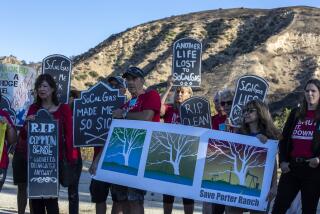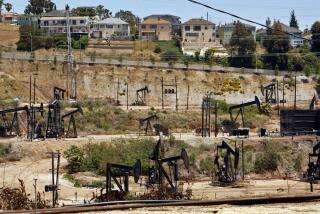Gas Boom Burdens Small Town
WAMSUTTER, Wyo. — Bob Ferguson took a hard pull on his umpteenth filter tip of the day and squinted across the dirt road and past the rows of double-wides. His eyes fell on the low-slung cluster of tidy beige buildings that comprise the town’s elementary school.
“Built in the last boom,” the mayor said, exhaling smoke and smiling.
Now, Wamsutter is a month into another economic boom, courtesy of a frenzy of drilling for natural gas here and across the state. And the school that gas built might soon be bulging at the seams with the children of gas workers.
With Wyoming poised to overtake Texas as the nation’s largest producer of natural gas, the towns and hamlets in the midst of the gas fields are girding for another in a series of explosive growth spurts that have become the natural rhythm of the state’s boom-and-bust cycle. The state budget, fat with taxes and royalties from oil and gas, boasts a $695-million surplus.
But for the small towns, the landscape is markedly different. Few seem to be reaping the windfall. And the mayor of Wamsutter is worried about everything from the school to the sewer and water systems to rowdy gas workers disrupting the town’s quiet lifestyle.
Though it has long been surrounded by oil and gas fields, Wamsutter--smack in southwestern Wyoming’s Red Desert--is also home to sand dunes, acres of rocks and prodigious herds of elk and antelope. The tiny mile-square town is near Interstate 80, a busy transportation corridor filled with big rigs and tourists rushing elsewhere.
The community of fewer than 500 people is in the center of the drilling. Approval has been given for more than 2,000 new wells on a million nearby acres. But, rather than jumping for joy at the potential income to the town, city officials are busy calculating what the influx of trucks and workers will cost them.
Towns like this one can expect to double or triple in size with the arrival of gas field workers and their families. Few have sewers, roads or a water supply able to support such rapid growth. And, unlike the state or counties, which receive property taxes and other income from the industry, small towns just see a modest infusion from sales taxes.
In a town as small as Wamsutter, said David Black, a senior economist for the Wyoming Division of Economic Analysis, even a modest influx of workers can overwhelm city services. Black said that the tax structure benefits the state more than municipalities so that when boom times come, local benefits are few.
“You have growth your infrastructure simply can’t handle,” he said.
These days, when Ferguson looks out from under the brim of his straw cowboy hat, he sees problems and potential problems: Wamsutter’s population has already doubled from a year ago to nearly 500, and the drilling has only just begun. Desert School, which had 61 students last year, is sure to see an increase in enrollment in the fall but no one has any idea of how much. There is no more available housing for the 600 workers who have arrived in the area, and nearly every dusty lot in town is occupied with trailers and motor homes.
“Water, streets and sewers, that’s what I’m concerned about,” Ferguson said, steering his pickup truck during a town tour. “The more demand you have on the town, the more demand you’ll have on the sewer lines. The more people you have on your streets, the worse condition your streets are in.”
Before drilling began in May, Wamsutter commissioned a study that projected the total cost of the boom’s effect on the town at $9.6 million. Major capital improvements included upgrading the town’s sewage and water systems, paving roads and adding a police officer. This, for a town with an annual budget of $220,000.
This is not a region accustomed to crowds or sudden movement.
There are three gas stations, two cafes, two small hotels, one church and a hair salon. Most of those places are busy. For everything else--a doctor, a supermarket or a video store--residents must drive 40 miles east to Rawlins or 70 miles west to Rock Springs.
It’s a lifestyle that people here enjoy. Or used to.
Once quiet and peaceful, Wamsutter is a town where doors are left unlocked and truck keys are left in the ignition. Now it is filled with strangers and often rough oil field workers who jam the lone bar at night.
“Basically, the oil people are good, hard-working people,” Ferguson said, straining to be fair. “But you can get some real stinkers.”
Some residents are almost at the point of locking up the young women in town. Karen Smith owns Wamsutter Cutters, the only beauty parlor. Conversations in her shop tend to turn to the gas fields, the money and the men. Smith counsels young girls to turn a deaf ear to the flirting they may hear from lonely workers.
Smith, shooting a knowing look across a table at two teenage girls, said she worries about the town’s youth. “These are beautiful girls we have here. Let’s put it this way: There really are no single women in this town. These guys are young, making $21.50 an hour and there’s nothing for them to do. You figure it out.”
The workers are drawn by the high wages and plentiful jobs. There is so much work here that most employees are imported from Texas and Louisiana, and there’s even some veteran oil hands from Alaska’s North Slope. Many are living in “man camps,” dormitory-style trailers set up at the well sites.
The area’s largest employer, BP Amoco, has attempted to mitigate its effect by helping the town apply for grants from the county and state, purchase a new fire engine and ambulance, and open a library--the town’s first.
The drilling here is projected to last four years, and the wells, once drilled, should produce natural gas for 30 to 50 years. That means continued long-term work for people here, servicing the wells and trucking the oil byproducts of gas production.
There is a strong sentiment to make the most out of whatever benefit the drilling can bring. At a recent town meeting, residents called for the construction of a grocery store, Laundromat and movie theater. But the town might not be quite big enough yet to support them.
Ferguson would be happy to see the town grow and improve and retain some of the workers as permanent residents.
“We’d like about 100 good people,” he said wistfully. “But we can realistically expect about 50 to stay.”
More to Read
Sign up for Essential California
The most important California stories and recommendations in your inbox every morning.
You may occasionally receive promotional content from the Los Angeles Times.











